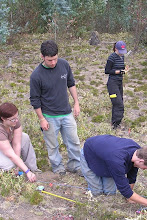Well, I´m almost home. Tonight is my last night, and at 4 am I will catch a taxi to the airport and start on my way. I only have 2 layovers, and they´re only 1 hour each, so this should be an easy trip [assuming none of my flights are delayed... cross your fingers for me?] I´ve spent the last week in Quito with some other stragglers from the project, and it has been great.
Tuesday, one of the students, Laurie, and I decided it´d be fun to climb a mountain. We didn´t feel like being cold, so we chose one of the shorter ones to climb that only went up to 4900 meters. The snow line doesn´t start until 5000, so we were in the clear. We took the TelefériQo, the gondola up part of the mountain, up above Quito to the lookouts where all the non-hiking tourists stop, and then took a trail up the ridge toward the Pichincha volcano´s craggy top. Every 10 minutes of walking proved noticeably harder to breathe, but luckily we were already fairly acclimatized from our oh-so-rigorous field school experience. The summit was hidden behind forboding clouds, and as we climbed higher and higher we found ourselves surrounded by swirling clouds that grew darker and darker. A group of French hikers passed us going back saying that it was about to rain and we should probably turn back. I know what it looks like when it´s about to rain, and this was not it, so Laurie and I kept on trekking.
As we looked down at the mountains below us, we noticed strange dotted terrace-looking things, hundreds of them, built along the contours of the mountains. These peaked our archaeological interests-- what if they were ancient Inka agricultural terraces? But we´d come to climb the mountain and gosh darnit we were going to get to the top.
We kept ascending, took a break to eat my leftover beef fried rice for lunch, and surveyed our options. The clouds had cleared just enough at that point for us to see the peak we were aiming for and notice that it was surrounded by a sheer rock wall, one that we would need special equipment to climb. We estimated our elevation to be at about 4500 meters at that point, halfway between the start point and the inaccessible summit, and figured this would be a great time to find out what the heck those darn terrace things were.
There were two main sets of them. To get to one, we´d have to go down a 75-degree-ish slope for 100 meters into a ravine, then back up a similar grade on the other side. To get to the other set, we could take a leisurely stroll down a shallow valley and just go on to the other side where they were all waiting for us to investigate. It was a hard choice, but we went the valley way.
This hike took us over so many types of plants that I´d never seen before, it felt like we were on another planet. Some of these plants looked like they belonged in a coral reef, not on top of the Andes. The valley leads directly to the crater of the Pichincha volcano, so maybe the lava flowing through there in previous years had something to do with the strange flora. Either way, we traipsed through the coral planet, on to the mini-evergreen trees planet, and into the utopian soft green mounded moss planet. We crossed a stream that desperately needed a bridge, crossed more moss that built itself up in ridiculous, not-very-sturdy mounds and finally arrived at the features we had assumed were terraces. They weren´t. They were hundreds and hundreds of trenches that we estimated at about a half-meter wide and 5-6 meters long, with walls far too straight and nice in soft soil to be ancient. Laurie and I puzzled over them for a while, then went to the church being constructed near the top of the TelefériQo to ask a local what the hell we found.
We found a fellow mosying around the roads up there, and I asked if he knew what these were. At first, he said they were very rare. I told him there were hundreds of them. Then he said they were Inka, and I essentially told him he was full of shit. Then he finally gave in and told us the not very exciting story:
About 8 years ago, the water management department got workers from the Chimborazo community to come up and dig lots and lots of trenches. That way, when it rained, they would fill up and slowly release the rain water into the groundwater and streams up at the top, and that would then go into a big canal that provided water for Quito down below. These trenches would also help keep the valley with the awesome extraterrestrial plants from flooding and killing all of those awesome plants. That´s it. Then he told us lots of foreigners tend to think they´re Inka tombs [they´re only a half meter by 6 meters... were the Inka crazy noodle people??] or agricultural terraces [guilty... until I saw them up close], and a lot of folks go looking in them for gold. Then he told us a little about Quito´s hostory, blah blah, you get the idea.
Other than that, I´ve just been eating cheap and walking around Quito. I´m out of money, but I can get any full meal I want here for $3 or less. It´s spectacular. Quito´s a great city, but I´m eager to get back to Chicago and start working again and seeing all the folks around there. I hope all is well with all of you, and I´ll be seeing you very very soon.
Subscribe to:
Post Comments (Atom)

No comments:
Post a Comment